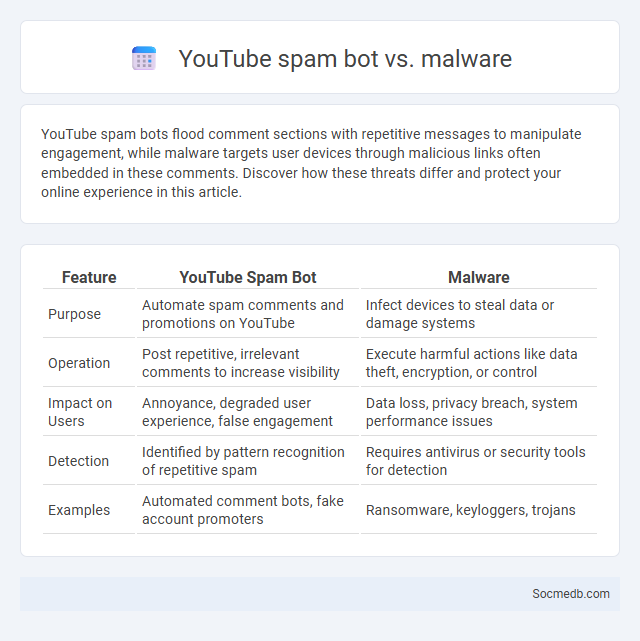
Photo illustration: YouTube spam bot vs malware
YouTube spam bots flood comment sections with repetitive messages to manipulate engagement, while malware targets user devices through malicious links often embedded in these comments. Discover how these threats differ and protect your online experience in this article.
Table of Comparison
| Feature | YouTube Spam Bot | Malware |
|---|---|---|
| Purpose | Automate spam comments and promotions on YouTube | Infect devices to steal data or damage systems |
| Operation | Post repetitive, irrelevant comments to increase visibility | Execute harmful actions like data theft, encryption, or control |
| Impact on Users | Annoyance, degraded user experience, false engagement | Data loss, privacy breach, system performance issues |
| Detection | Identified by pattern recognition of repetitive spam | Requires antivirus or security tools for detection |
| Examples | Automated comment bots, fake account promoters | Ransomware, keyloggers, trojans |
Introduction to YouTube Spam Bots
YouTube spam bots are automated programs designed to post repetitive or irrelevant comments, artificially inflate views, and manipulate engagement metrics on the platform. These bots contribute to degraded user experience by flooding comment sections with promotional messages, misleading links, or malicious content. Detecting and mitigating YouTube spam bots is critical for maintaining authentic interactions and protecting the platform's community integrity.
Understanding Malware: Definition and Types
Malware, short for malicious software, encompasses various harmful programs designed to infiltrate and damage devices through social media platforms. Common types include viruses, worms, trojans, ransomware, spyware, and adware, each varying in method and purpose of attack. Recognizing these malware types is crucial for safeguarding personal information and maintaining cybersecurity on social media networks.
Spam Bots Explained: What Sets Them Apart?
Spam bots are automated accounts designed to distribute unsolicited messages, often flooding social media platforms with irrelevant or promotional content. Unlike genuine users, these bots operate at high volumes, deploying repetitive posts and comments to manipulate engagement metrics or spread misinformation. Advanced spam bots use AI to mimic human behavior, making detection increasingly challenging for platform moderators.
Key Differences Between YouTube Spam Bots and General Spam Bots
YouTube spam bots specifically target video content by posting misleading comments, fake likes, and fraudulent subscriptions to manipulate engagement metrics, unlike general spam bots that often distribute unsolicited messages across emails or social platforms. YouTube spam bots exploit the platform's algorithm by generating automated, repetitive content designed to boost visibility or drive traffic to malicious sites. General spam bots typically focus on bulk messaging or phishing attacks without platform-specific engagement strategies.
How Malware Differs from Spam Bots on YouTube
Malware on YouTube typically involves malicious software designed to infiltrate users' devices, compromising security and stealing sensitive information, while spam bots generate repetitive, irrelevant comments or channel subscriptions to manipulate engagement metrics. Malware operates covertly to exploit vulnerabilities, whereas spam bots function as automated accounts aiming to distort user experience and platform analytics. Understanding these differences helps in developing targeted strategies for content moderation and cybersecurity on social media platforms.
Common Techniques Used by YouTube Spam Bots
YouTube spam bots commonly use automated commenting tools to flood popular videos with repetitive and irrelevant messages, often containing malicious links or promotional content. These bots exploit trending hashtags and keywords to increase the visibility of their spam, targeting high-traffic channels for maximum impact. Machine learning algorithms enable sophisticated bots to mimic human behavior, bypassing YouTube's spam detection filters.
Identifying Signs of Malware Versus Spam Bots
Social media platforms often experience malicious activities, where malware typically manifests through suspicious links or unexpected downloads that compromise device security. Spam bots, contrastingly, generate repetitive, irrelevant content or send mass unsolicited messages aimed at disrupting genuine user interactions. Recognizing malware involves detecting unusual account behavior and automated spam bots by observing repetitive posting patterns and lack of personalized engagement.
Potential Threats Posed by Each: YouTube Spam Bots, Malware, and Spam Bots
YouTube spam bots flood comment sections with irrelevant links and misleading content, undermining user experience and promoting malicious sites. Malware distributed through social media platforms can infect devices, steal personal information, and compromise account security. Generic spam bots, prevalent across networks, automate the spread of fraudulent messages and phishing scams, damaging platform integrity and user trust.
Prevention and Protection Strategies for Users
Effective prevention and protection strategies on social media include setting strong privacy settings, regularly updating passwords, and being cautious about sharing personal information. You should enable two-factor authentication to add an extra layer of security against unauthorized access. Monitoring account activity and using trusted security software help safeguard your digital presence from cyber threats and identity theft.
Conclusion: Navigating the Landscape of Digital Threats on YouTube
Navigating the landscape of digital threats on YouTube requires constant vigilance against phishing scams, fake accounts, and misleading content that exploit the platform's vast user base. Employing advanced algorithms and community-driven reporting mechanisms enhances detection and mitigation of harmful activities. Users must remain informed about privacy settings and credible sources to protect their digital presence effectively.
 socmedb.com
socmedb.com